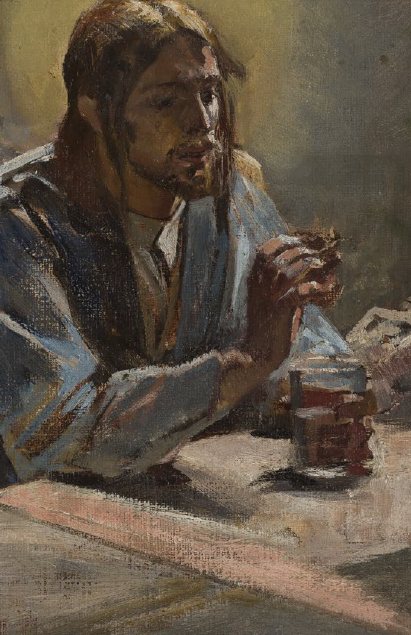Abstract
Religious themes related to Christianity hold a significant place in Jacek Malczewski’s art. This paper analyses all known oil paintings by the artist depicting the Supper at Emmaus. In most of them, Jesus and his disciples wear military greatcoats, and in some, Christ bears Malczewski’s features. Until now, these works have been interpreted as an expression of the artist’s hope that his work could awaken Poles’ hopes for a restoration of their country’s independence – just as Christ, by appearing to his disciples after his Resurrection, renewed their sense of the meaning of life. However, it has not been previously considered that the disciples in Malczewski’s paintings do not show signs of recognizing the Saviour. The earliest version, dating from 1897, shows diverse reactions to Christ’s gesture of breaking bread. In later works, however, the disciples gaze at the bread without perceiving it as a sign of transformation, or they avert their eyes in confusion. This text investigates why Malczewski’s paintings so evidently depart from traditional iconography. The author suggests that they refer to perceptions of Christ contemporary to Malczewski’s time, shaped by the revised meaning and historical role of Christianity in the era of biblical criticism – particularly the works of Ernest Renan – as well as the philosophy of Friedrich Nietzsche. The final painting in this series, created around 1925, has been interpreted as a summary in which Malczewski visualized the idea of the evangelical Eucharist as a mystery whose meaning can only be experienced in the liturgy.
References
Biały Aneta, ‘Wieczerza w Emaus Jacka Malczewskiego (1909)’, National Museum in Warsaw – Digital Collection, https://cyfrowe.mnw.art.pl/pl/zbiory/444972 [retrieved: 12 Jan. 2024].
Drei. Das Triptychon in der Moderne, ed. Marion Ackermann, exh. cat., Kunstmuseum Stuttgart (Stuttgart, 2009).
Kemp Wolfgang, Der Anteil des Betrachters. Rezeptionsaesthetische Studien zur Malerei des 19. Jahrhunderts (Munich, 1983).
Kowalski Leon, ‘Ostatni tryptyk Malczewskiego’, Krytyka. Miesięcznik poświęcony sprawom społecznym, nauce i sztuce, Ann. 11, vol. 4 (1909), p. 327.
Kudelska Dorota, Dukt pisma i pędzla. Biografia intelektualna Jacka Malczewskiego (Lublin, 2008).
Lankhait Klaus, Das Triptichon als Pathosformel (Heidelberg, 1959).
Malczewski Jacek, [survey response], Przegląd Powszechny, Ann. 23, vol. 90, no. 23 (1906), p. 80.
Problematyka religijna w literaturze pozytywizmu i Młodej Polski, ed. Stanisław Fit (Lublin, 1993).
Puciata-Pawłowska Jadwiga, Jacek Malczewski (Wrocław, 1968).

This work is licensed under a Creative Commons Attribution 4.0 International License.
Copyright (c) 2024 Michał Haake (Autor)


